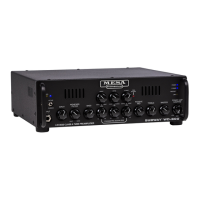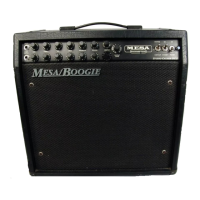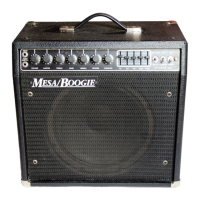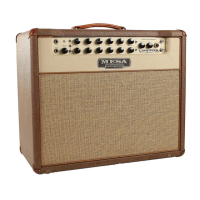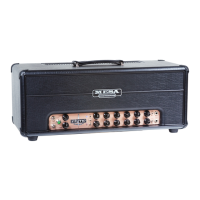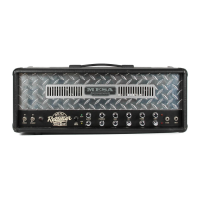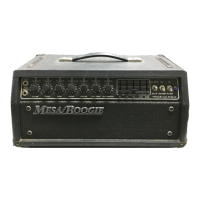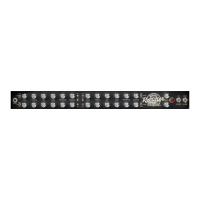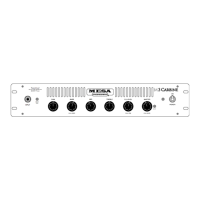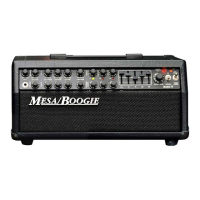MID FREQ CONTROL:
This control shifts the response of the MID CONTROL as the control is rotated clockwise from the
normal “classic” position. In the fully clockwise (shifted) position, the amp will be voiced flatter with a little more of a modern feel. This
control simultaneously adjusts both the range and the effective Q of the midrange filter, becoming narrower and steeper as the control
is rotated counter-clockwise. Don’t worry about the technicalities though, just experiment and let your ears be the guide.
TREBLE CONTROL:
This control is a shelving type filter responsible for the amount (or volume) of high frequencies present in
the signal, relative to the rest of the spectrum. High frequencies (>2.5kHz) are responsible for the “bright”, “airy”, “clarity”, “shimmery”
character of the tone. In this classic circuit, there is quite a bit of high frequency boost available, which might appeal to some styles
(especially slap), and also with tweeterless cabinets, but in general better results are obtained with the control operated in the 9:00
to 2:00 position.
CHANNEL “MASTER” VOLUME CONTROL:
This control is responsible for the level of the BOOGIE CHANNEL being
sent to the power amp, and determines the playing volume of the BOOGIE CHANNEL relative to the SUBWAY CHANNEL. Using the
CHANNEL MASTER VOLUME along with the INPUT GAIN control allows the optimal control over playing volume. For example, if
you are using high input gain to achieve an overdriven tone, it will be likely be necessary to adjust the CHANNEL MASTER VOLUME
down to obtain a reasonable playing volume. Likewise, if you are looking for a very clean tone, you may wish to start with a lower
INPUT GAIN control setting and use a higher CHANNEL MASTER VOLUME control setting to obtain the desired playing volume.
The CHANNEL MASTER VOLUME control operates in a linear fashion, an increase in volume continues linearly throughout the
entire rotation of the control.
SUBWAY CHANNEL:
GAIN CONTROL:
This control determines the gain (drive level) of the SUBWAY CHANNEL’s 12AT7 (or 12AU7) vacuum tube
gain stage (V3A & V3B). Overdriving this gain stage may be a desirable tonal characteristic of your playing style. To increase the
amount of overdrive beyond what the range of this control allows, simply switch the INPUT GAIN SWITCH to the high gain position.
When using significantly overdriven tones, you may find it helpful to back down on the TREBLE EQ a little bit to reduce harshness
and also to reduce the BASS EQ (and/or increase the frequency on the high pass filter) to increase the clarity and impact. This hybrid
tube gain circuit draws inspiration from elements of our legacy amps, including the Walkabout, Carbine, and even from the legendary
Bass 400/400+. If it’s your tone, this tube gain stage is designed to be overdriven, so give it a try. When employing heavier overdrive,
it’s generally more pleasing reduce the tweeter level if your cabinets have tweeters. Note that the GAIN control operates in a linear
fashion, an increase in gain continues linearly throughout the entire rotation of the control. The amount of overdrive is increased by
turning the GAIN CONTROL up beyond the clean area of operation, and the overall volume will be controlled by turning the CHAN-
NEL VOLUME down as needed.
HIGH PASS FILTER:
This control sets the low frequency roll-off point of the amplifier channel, and is an important feature in
maintaining control over the extreme low end (especially under high drive conditions). This precision two pole variable filter is adjustable
from 25Hz to 125Hz. While HPF’s have been standard fare within the pro audio industry for decades, this feature has only appeared
in bass guitar amplifiers within the past few years (with some notable exceptions). This filter provides additional mechanical protec-
tion to the speakers from over-excursion by reducing the power to the speaker below the frequency range that the speaker cabinet
provides adequate acoustic loading to the speakers. This is one of the primary (and preventable) causes of premature speaker failure,
especially with compact speaker cabinet products that are driven very hard. A second use for this filter is to roll off the very low end
when overdriving the amp. This prevents the signal from becoming muddy, and preserves the naturally musical growl and grit of the
overdriven signal. A third use is for rolling off the extreme low end when boosting the bass eq control, allowing for some unique low
mid voicings, and a fourth use is for reducing the sub-bass frequencies that can get out of hand in a boomy room. Experimentation
will be helpful in all of these applications. This control sweeps between a linear scale between the labeled endpoints. The 12:00
position equates to ~75Hz.
BASS CONTROL:
This active eq control is a shelving filter that is responsible for the amount (or volume) of low frequencies
present in the signal, relative to the rest of the spectrum. Low frequencies (<80Hz) are responsible for the “depth”, “bottom”, “round-
ness”, and “feel” of the tone. This is an active control with boost and cut, the amount of boost proportional to the clockwise rotation
to the right of “flat” (12:00 straight up) position and the amount of cut proportional to the counter-clockwise rotation to the left of “flat”
(12:00 straight up) position. As with everything related to EQ, generally, a little bit goes a long way. The HIGH PASS FILTER control,
PAGE 6
